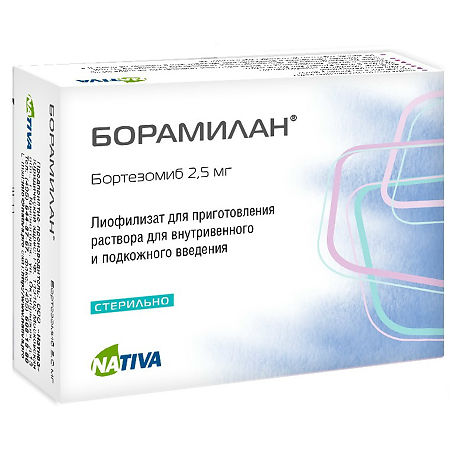No products in the cart.
Description
Pharmacodynamics: Bortezomib is a reversible inhibitor of chymotrypsin-like activity of 26S-proteasome of mammalian cells. The proteasome is a large protein complex that cleaves proteins conjugated to ubiquitin. The ubiquitin-proteasome pathway plays a key role in regulating the intracellular concentration of certain proteins and thus maintains intracellular homeostasis. Suppression of 26S-proteasome activity prevents selective proteolysis, which can affect many cascades of signal transduction reactions in the cell. Disruption of the homeostasis maintenance mechanism can lead to cell death. In many in vivo experimental models bortezomib causes tumor growth inhibition, including multiple myeloma. In in vitro, ex vivo and animal models bortezomib enhances differentiation and activity of osteoblasts and inhibits osteoclast function. These effects were observed in patients with multiple myeloma with multiple foci of osteolysis receiving bortezomib therapy. Absorption When bortezomib is administered intravenously by jet injection at doses of 1.0 mg/m2 and 1.3 mg/m2 to patients with multiple myeloma, the maximum plasma concentrations (Cmax) of bortezomib are 57 ng/mL and 112 ng/mL, respectively. On subsequent administration of the drug, maximum plasma concentrations range from 67-106 ng/mL for the 1.0 mg/m2 dose and 89-120 ng/mL for the 1.3 mg/m2 dose. Maximum concentration (Cmax) of bortezomib after subcutaneous administration (20.2 ng/ml) is lower than after intravenous administration (223 ng/ml). When administered at a dose of 1.3 mg/m2 subcutaneously and intravenously in patients with multiple myeloma, total systemic exposure after repeated administration at the same dose (AUClast) is equivalent for both routes. Distribution After single or repeated administration at doses of 1.0 mg/m2 and 1.3 mg/m2, the mean volume of distribution of bortezomib in patients with multiple myeloma is 1659-3294 L (489-1884 L/m2). This suggests that bortezomib is intensively distributed in peripheral tissues. At bortezomib concentrations of 100-1000 ng/ml the drug binding to plasma proteins is on average 83%. Metabolism Under in vitro metabolism of bortezomib is primarily performed by cytochrome P450 isoenzymes – CYP3A4, CYP2C19 and CYP1A2. Participation of CYP2D6 and CYP2C9 isoenzymes in bortezomib metabolism is insignificant. The main pathway of metabolism is the detachment of boron atoms to form two metabolites, which are further hydroxylated to form several other metabolites. Bortezomib metabolites do not inhibit 26S-proteasome. Excretion The average elimination half-life of bortezomib when administered repeatedly is 40-193 hours. The drug is rapidly eliminated after the first dose compared to subsequent administrations. After the first injection of 1.0 mg/m2 and 1.3 mg/m2 doses, mean total clearance is 102 l/h and 112 l/h, respectively, and after subsequent injections – 15-32 l/h, respectively. The excretion routes of bortezomib in humans have not been studied. The effect of sex, age and race on bortezomib pharmacokinetics has not been studied. Pharmacokinetics in patients with hepatic and renal dysfunction Mild hepatic dysfunction has no effect on the pharmacokinetics of bortezomib. In patients with moderate to severe hepatic impairment a 60% increase in AUC (area under the curve “concentration – time”) of bortezomib is observed compared to patients with normal hepatic function. For patients with moderate to severe hepatic dysfunction it is recommended to reduce the initial dose of bortezomib and dynamical monitoring. Pharmacokinetics of bortezomib at doses of 0.7-1.3 mg/m2 intravenously twice weekly in patients with mild, moderate and severe renal impairment, including patients on dialysis, is comparable to pharmacokinetics of the drug in patients with normal renal function.
Indications
Indications
Active ingredient
Active ingredient
Composition
Composition
How to take, the dosage
How to take, the dosage
Interaction
Interaction
Contraindications
Contraindications
Side effects
Side effects
Overdose
Overdose
Additional information
| Weight | 0.033 kg |
|---|---|
| Shelf life | 3 years |
| Conditions of storage | In a place protected from light at a temperature not exceeding 25 oC. After reconstitution the solution should be stored at the temperature not more than 25 oC in natural light in the original bottle or syringe for not more than 8 hours. Keep out of reach of children. |
| Manufacturer | Nativa, Russia |
| Medication form | solution for injections and infusions |
| Brand | Nativa |
Related products
Buy Boramilan lyophilizate 2.5mg with delivery to USA, UK, Europe and over 120 other countries.















